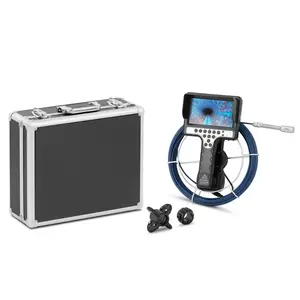Endoscopes inspection cameras

Endoscope Camera - 30 m - 12 LEDs - 9" TFT colour display
Lowest price in the 30 days before the discount: €1,249.00

2 pipe cameras - 20 m + 40 m - 18 + 12 LED - 10" display
Lowest price in the 30 days before the discount: €4,179.00
- First
- 1
- Last
Endoscopes and borescopes – gain visual access to poorly accessible areas
Endoscopes and tube cameras used in technical fields are also called inspection cameras. They are valuable tools for visually inspecting areas that are not directly accessible. With endoscopes and pipe cameras, you can, for example, inspect the insulation of your roof without causing major damage to the building fabric. Inspection cameras are characterized by their small size. A small hole is all that is needed to bring the camera to its field of use.
An important application of pipe cameras is the inspection of sewage pipes in buildings. With the help of a sewer camera, even large pipelines can be inspected. The radius of action of a camera for pipes depends on the length of the connecting cable between the camera and the monitor. Portable pipe cleaning cameras can have 50 to 60 m long lines.
Inspection cameras – available types
Inspection cameras differ in terms of their area of application, range, image quality and transmission technology.
Rigid endoscope
Rigid endoscopes are used in the technical field in the form of borescopes. Rigid endoscopes transmit the image information from the lens to the eyepiece or screen via a fixed connector. If a rigid endoscope is used as a drain camera, the radius of action is limited to a small area.
Flexible endoscope
Flexible endoscopes offer more flexibility and are well suited for cavities in buildings or vehicles. Using a flexible endoscope as a tube camera is useful when no large radius of action is required and changes in direction are necessary when inserting the tube endoscope. This may be the case in the downspouts of gutters as well as for inspecting a sink siphon.
Mobile hand-held endoscopes are a particularly handy form of flexible endoscopes. These are small handheld devices with an integrated display. A line is connected to the handset and carries light to the camera and image information from the camera to the display. The flexible cable, sometimes called a gooseneck, typically has a length of between 0.5 and 2 meters. In addition, a part of the endoscope camera has a movable head.
Pipe camera
A pipe camera, drain camera or sewer camera is designed for inspecting longer sections of pipe. Cameras for pipe cleaning have a camera head with lighting, a flexible cable that can handle curves, and a base unit. The base unit of the pipe camera or channel camera contains a display and a light source. For documentation purposes, data memory and interfaces for external storage media are also important.
USB Endoscope Camera
A USB tube camera does not require a display. This type of inspection camera connects to a smartphone, tablet or any other terminal device with a display via a USB interface. The memory of the end device serves as the storage medium.
How do I use a drain camera?
The connecting lines of pipe cameras are characterized by their ability to transmit data in both directions. First, the image information must be transferred from the camera to the display of the tube camera. On the other hand, lighting, without which hardly any useful images can be taken with an inspection camera, must be supplied with power. Depending on the technology, both image data and the power for the LED lighting can be transmitted via electrical lines. The light transmission from a light source in the base station to the camera head can also go through fibre optic cables. The image information can also be transmitted via fibre optic cable from the camera to the base station for further processing.
Buying a drain camera – what do I need to consider?
The cost of a camera for pipe inspection depends on the desired quality of the image material. The length of the connecting line is also a relevant cost factor. Some manufacturers of channel cameras offer different models, the operating radius of which can range from less than one to 50 m and more.
Some manufacturers of sewer cameras offer guide stars of different sizes for their inspection cameras. These help to guide the drain cameras into the central area of a pipe. The decisive factor for the pipe material is that it is flexible enough to handle angles in the pipe. On the other hand, the cable must be rigid enough to allow the inspection camera to be inserted over longer distances.
Pipe inspection – how does it work?
In our assortment at Expondo.co.uk, you can find a rich selection of pipe fitting tools, including drain cleaning machines. To determine if there is a leak and if damage has already been caused by wastewater, a moisture meter can be a valuable tool.









